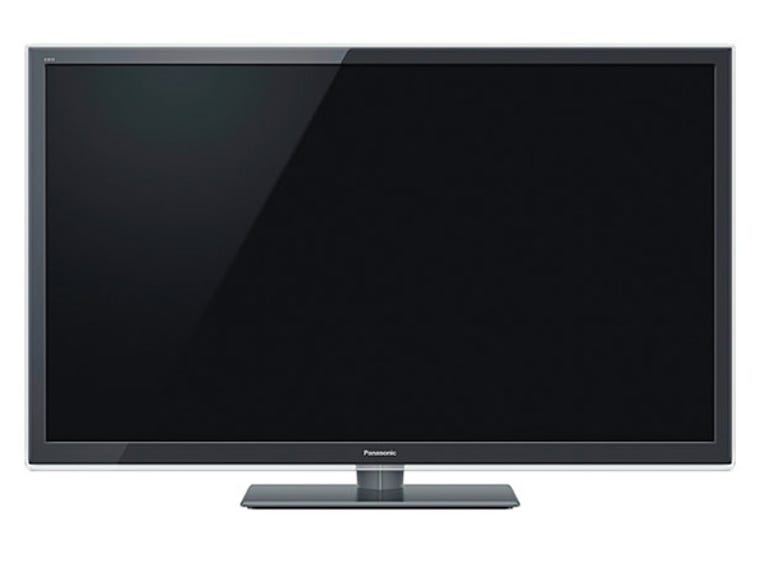 Why You Can Trust CNET
Why You Can Trust CNET Panasonic Viera TH-L47ET5A review: Panasonic Viera TH-L47ET5A
The Panasonic Viera TH-L47ET5A offers strong performance on all fronts, especially with 3DTV — at a very respectable price.
System
As we noted with our review of Panasonic's Viera TH-L47ET50A (look carefully, there is only one digit of difference in the model number), we are reviewing two 47 inch (119cm) Panasonic LCD TVs. The other offers active 3D. This one is notable primarily for using passive 3D technology. Instead of flashing the left and right eye views up on the screen in sequence, it shows them both at the same time on alternating horizontal rows of pixels. Since there are just the usual number of pixels — the screen's full HD resolution is 1,920 by 1,080 — the vertical resolution is reduced in 3D mode (and only in 3D mode). By how much is a topic of controversy.
The Good
The Bad
The Bottom Line
One big advantage of passive 3D technology is that the eyewear works simply by means of polarised lenses, similar to the way 3D is presented in the cinema. Consequently, they are relatively light and cheap. Panasonic supplies four pairs with this TV (additional sets are $30 for two, or you can just use the ones you get from the movies). The supplied ones weigh only 17 grams.
Other than styling and price (this one costs AU$300 less than the L47ET50A), there isn't too much to distinguish between the models. This one apparently lacks the more advanced "8 train speakers" used by the other model (according to the manual, but not Panasonic's website), but it sounds adequate anyway, which is all you can ask from the built-in speakers of any TV. It is a little less slender at 52mm deep, and has a more substantial frame around the picture — around 35mm. The swivel stand has a straight rather than forward-reaching pedestal.
The TV supports time shifting and recording if you're prepared to plug a dedicated USB hard disk drive into it.
Picture
The 3D performance was top notch, in terms of crosstalk rejection. On the static test, instead of the 30, 40 or even 50 per cent of the leakage shown by many active 3D systems, this TV scored about 5 per cent for white leaking through a black background from one eye to the other, and 0 per cent the other way around. Nor was there any colour shift (so long as you look straight through the lens, rather than turning your head, which would make the light enter the lens at an angle).
But we noticed something strange when checking compatibility. The crosstalk was a touch lower with both RealD 3D glasses from a cinema and LG TV 3D glasses. There wasn't much in it, but if you have some previously purchased 3D glasses, try them out.
To optimise your 3D experience, you will, of course, need to make some changes to the picture settings. There is no way that a TV should default to having "Overscan" switched on when watching Blu-ray 3D discs, but this one does (you can switch it off under Picture, then Advanced Settings). Switch it off for normal Blu-ray, as well.
And wind down that "Sharpness" control, which defaults to a picture-harshening "50".
Those changes made the 2D picture quality nice, with good black levels that were fairly even across the screen. The "Eco" mode allows even deeper black levels if you're watching in the dark, as it monitors ambient light levels and reduces the brightness to almost match, though it reduced it a touch too much for our taste, though.
On Blu-ray 3D movies, the performance was brilliant. This TV delivered enormous depth with no distracting ghosting, even on really challenging material, such as Happy Feet Two. But you must sit further away than you would with an active TV. In the manual, Panasonic recommends 1.8 metres, the same as for active TVs. At that range, the horizontal line structure of the TV was just on the edge of visibility in 3D mode, and jaggies were still visible sometimes. We'd suggest 2.4 metres.
Goodies
There was no difference on this front between this TV and the other Panasonic model. The Panasonic Viera Connect facility offers the usual free stuff, including YouTube, ABC iView and the other catch-up services, Shoutcast Internet radio, social networking and a bunch of overseas services, but not Bigpond TV, nor the Bigpond NRL and AFL Games Analyser apps. It does have some subscription stuff too, including Bigpond Movies and Quickflix.
Skype is supported with the addition of an optional camera. You can also plug in a USB keyboard to make Facebook, Twitter and web surfing easier. Panasonic's Viera remote app on iOS worked nicely — except for the five seconds or so it needed to connect each time — once again allowing photos and video to be pushed to the TV, providing various options for controlling it. The DLNA and USB photo and video viewing functions worked snappily, and standard music types, excluding WAV but including FLAC, is supported.
Overall
The Panasonic Viera TH-L47ET5A garners itself a good score for its excellent value for money and fine 3D performance. But it has good all round performance in other criteria, as well.


